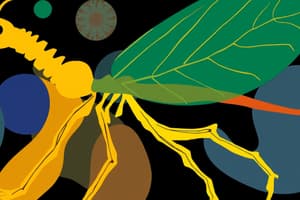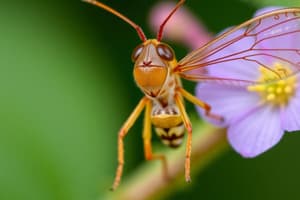Podcast
Questions and Answers
What is a classification system used for?
What is a classification system used for?
- To determine the age of organisms
- To identify environmental impacts
- To study the diversity of life (correct)
- To describe the habitats of organisms
What is taxonomy?
What is taxonomy?
The study where scientists classify organisms and assign a universally accepted name.
Who is Carolus Linnaeus?
Who is Carolus Linnaeus?
A Swedish botanist who developed a two-word naming system called binomial nomenclature.
Binomial nomenclature assigns each species a two-part scientific name where the first word is the ______.
Binomial nomenclature assigns each species a two-part scientific name where the first word is the ______.
What is LSC (Linnaeus' System of Classification)?
What is LSC (Linnaeus' System of Classification)?
What is the largest taxonomic category in Linnaeus's classification system?
What is the largest taxonomic category in Linnaeus's classification system?
What is Phylum in Linnaeus's system?
What is Phylum in Linnaeus's system?
What does Class refer to in Linnaeus's classification system?
What does Class refer to in Linnaeus's classification system?
What is an Order in Linnaeus's classification system?
What is an Order in Linnaeus's classification system?
What is a Family in biological classification?
What is a Family in biological classification?
What is the definition of Genus?
What is the definition of Genus?
What defines a Species?
What defines a Species?
What is cladistic analysis used for?
What is cladistic analysis used for?
What are derived characteristics?
What are derived characteristics?
What is a cladogram?
What is a cladogram?
Flashcards are hidden until you start studying
Study Notes
Classification System
- A framework used by biologists for studying life’s diversity, naming organisms, and logically organizing them.
Taxonomy
- The scientific study concerned with classifying organisms and assigning universally accepted names.
Carolus Linnaeus
- A Swedish botanist recognized for creating binomial nomenclature, a two-word naming system for species.
Binomial Nomenclature
- Each species gets a two-part scientific name; the first word is capitalized (genus) and the second is lowercase (specific description). Example: Ursus maritimus.
LSC (Linnaeus' System of Classification)
- This system categorizes organisms based on structural similarities and operates within a hierarchical structure consisting of seven levels, from broadest to most specific.
Kingdom
- The most inclusive and largest category in Linnaeus's taxonomy, providing the broadest description of an organism.
Phylum
- Represents a category that includes multiple organisms sharing significant characteristics; phyla collectively create kingdoms.
Class
- Comprises groups of similar orders; multiple classes exist within a phylum.
Order
- A broader category made up of similar families; orders are subdivisions of classes.
Family
- Contains genera that exhibit shared traits, forming a constituent of orders.
Genus
- Encompasses closely related species and is the first part of the binomial nomenclature.
Species
- Defined as a population of organisms with similar traits capable of breeding to produce fertile offspring.
Cladistic Analysis
- A method for identifying and analyzing characteristics that evolve in organisms over time.
Derived Characteristics
- Features that have emerged in recent parts of evolutionary lineage, differing from those of older ancestors due to mutations and evolutionary change.
Cladograms
- Diagrams that utilize derived characteristics to illustrate the evolutionary relationships among groups of organisms.
Studying That Suits You
Use AI to generate personalized quizzes and flashcards to suit your learning preferences.




